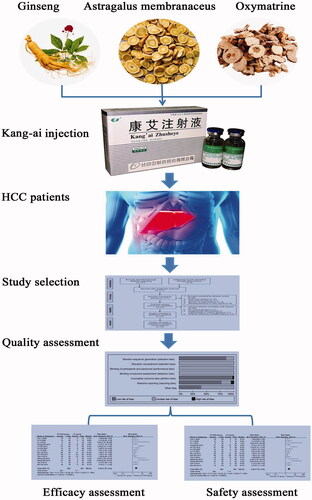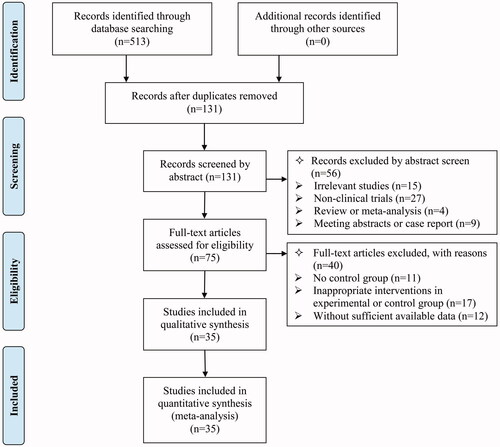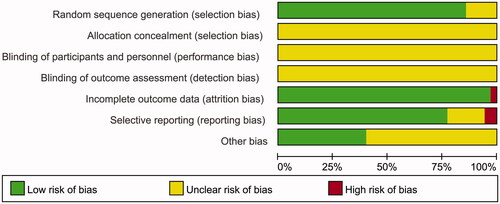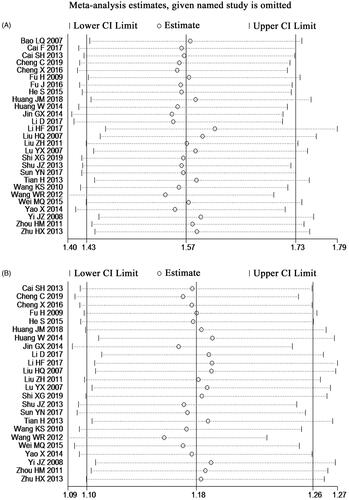Abstract
Context
Kang-ai injection (KAI) is an authorized herbal medicine used in cancer treatment. However, its clinical efficacy in hepatocellular carcinoma (HCC) has not been investigated thoroughly.
Objective
To systematically evaluate the efficacy and safety of KAI in patients with HCC.
Materials and methods
The Web of Science, PubMed, Cochrane Library, EMBASE, CBM, CNKI, VIP and Wanfang databases were systematically searched (date range: inception to December 2020) using the key terms ‘Kang-ai injection’ and ‘hepatocellular carcinoma’. The current analysis included controlled clinical trials that compared the efficacy and safety of the combination of KAI and conventional treatment (CT) with CT alone for HCC. The current study estimated the pooled risk ratio (RR) with 95% confidence intervals (CI).
Results
Data pertaining to 35 trials with 2501 HCC patients were analysed. The results revealed that the combination of KAI and CT was associated with significantly superior objective response rate (RR = 1.57, 95% CI = 1.43–1.73), disease control rate (RR = 1.18, 95% CI = 1.10–1.26), and quality of life (RR = 2.40, 95% CI = 1.79–3.23), compared to CT alone. The administration of KAI significantly alleviated most of the adverse effects caused by CT, including nausea and vomiting, liver damage, peripheral neurotoxicity, fever, abdominal pain, alopecia, increased bilirubin levels, leukopoenia, and reduction in haemoglobin levels (p < 0.05, for all).
Conclusions
The current meta-analysis indicates that a combination of CT and KAI could be more effective in improving the clinical efficacy of the treatment of HCC, compared to CT alone.
Introduction
Hepatocellular carcinoma (HCC) is the seventh most prevalent cancer and the third leading cause of cancer mortality across the world (Bray et al. Citation2018; Ferlay et al. Citation2019). In the year 2018, 841,100 new cases of HCC and 781,600 HCC-related deaths occurred worldwide (Bray et al. Citation2018; Ferlay et al. Citation2019). Regardless of the advances in diagnostic methods, early detection of HCC remains a challenging endeavour (Liu et al. Citation2019; Anwanwan et al. Citation2020). Moreover, a considerable number of patients with liver cancer progress to the intermediate or advanced stages, and the five-year survival rate is less than 17% (Liu et al. Citation2019; Zhu et al. Citation2019). Surgery and liver transplantation are considered to be the ideal treatment options for the management of HCC. However, potentially curative surgical resection is possible in only a small proportion of patients with HCC (Liu et al. Citation2019). Furthermore, it is universally acknowledged that the long-term use of Western medicine might occasionally cause drug resistance and toxic side effects. Consequently, the clinical efficacy of this mode of treatment remains unsatisfactory. Currently, treatment using traditional Chinese medicine has become a part of the modern comprehensive therapy pertaining to the research and treatment of HCC (Xi and Minuk Citation2018; Xue et al. Citation2018). Several reports have verified the unique therapeutic effect of Chinese medicine and its role in compensating for the deficiencies pertaining to the treatment using Western medicine (Li et al. Citation1994; Ma et al. Citation2017; Xi and Minuk Citation2018; Xue et al. Citation2018). Several scholars have reported that the combination of Chinese and Western medicine might be the future trend in the research and development of therapeutic modalities for the management of HCC (Ma et al. Citation2017; Ling et al. Citation2018).
Kang-ai injection (KAI), a Chinese patent medicine, is extracted from three Chinese herbs, namely, ginseng (Panax ginseng C.A. Mey. [Araliaceae]), milkvetch root (Astragalus membranaceus [Fisch.] Bunge [Fabaceae]), and Kushen (Sophora flavescens Ait. [Fabaceae]) (every 10 mL KAI contains 1 g ginseng, 3 g milkvetch root, and 100 mg oxymatrine) (Song et al. Citation2014; Lu and Li Citation2018; Song et al. Citation2020). It contains several active ingredients, such as Astragalus polysaccharides and astragalosides (the major, effective antitumor constituents of milkvetch root), ginsenosides and ginseng polysaccharides (the major, effective antitumor constituents of ginseng), and oxymatrine (Song et al. Citation2014; Li et al. Citation2019; Song et al. Citation2020). Several studies have suggested that KAI exerts antitumor effects by way of improving the body’s immune function, inducing tumour cell apoptosis, and inhibiting tumour cell proliferation, invasion, and metastasis (Wan et al. Citation2018; Huang et al. Citation2019; Li et al. Citation2019; Song et al. Citation2020). Moreover, it can effectively reverse multiple-drug resistance in cancer cells, improve the efficacy of chemotherapy, and reduce the adverse effects of chemotherapy (Wan et al. Citation2018; Huang et al. Citation2019; Li et al. Citation2019; Song et al. Citation2020).
In recent times, KAI has attained immense popularity in relation to the alternative and complementary treatment of advanced HCC. Clinical trials have indicated that KAI could significantly improve the efficacy of conventional therapy, reduce the toxicity associated with same, and play an irreplaceable role in clinical practice (Bao Citation2007; Yi et al. Citation2008; Liu Citation2011; Cai Citation2013; Huang et al. Citation2014; Wan et al. Citation2018). Regardless of the extensive research on the subject, the clinical efficacy and safety of the combination of conventional treatment and KAI have not been systematically evaluated to date. The present study performed a meta-analysis to investigate the efficacy and safety of the combination of conventional treatment and KAI in the management of HCC, compared to conventional treatment alone, in order to provide a scientific reference to facilitate the design and implementation of future clinical trials ().
Materials and methods
The present meta-analysis was performed in accordance with the Preferred Reporting Items for Systematic Reviews and Meta-analyses (PRISMA) guidelines (Moher et al. Citation2009).
Search strategy
The PubMed, Cochrane Library, Excerpta Medica database (EMBASE), Chinese Biological Medicine Database (CBM), China National Knowledge Infrastructure (CNKI), Chinese Scientific Journal Database (VIP), Web of Science, and Wanfang databases were searched to obtain the relevant randomized controlled trials (RCTs) using the following terms: ‘Kangai injection,’ ‘Kang-ai injection,’ ‘KA injection,’ ‘KAI’ combined with ‘liver tumour,’ ‘liver malignant,’ ‘liver carcinoma,’ ‘liver cancer,’ ‘hepatocellular carcinoma,’ ‘hepatocellular cancer,’ ‘hepatocellular tumour,’ and ‘hepatocellular malignant’ (Supplementary Table 1). The date range pertaining to the search was from the date of database inception to December 2020. The language was limited to English and Chinese. The search was conducted independently by two experienced authors (Sun & Dong) and any disagreements were resolved by a third independent investigator (Xiao).
Eligibility criteria
Inclusion criteria:
Randomized controlled trials (RCTs) involving patients diagnosed with advanced HCC;
Articles with a sample size of more than 40 HCC patients;
Studies comparing the clinical outcomes of the combination of conventional treatment and adjuvant therapy using KAI (experimental group) with conventional treatment alone (control group); conventional treatments included transcatheter arterial chemoembolization, chemotherapy, supportive care, and symptomatic treatment;
One or more outcome measures, including the therapeutic effect, quality of life (QoL), or adverse events must be included in each study.
Exclusion criteria:
Studies that did not focus on HCC;
Unsuitable criteria with regard to the experimental or control groups;
Articles without sufficient available data;
Non-clinical studies, literature reviews, meta-analysis, meeting abstracts, case reports, and experimental research.
Data extraction and quality assessment
The following data were extracted from eligible reports: name of the first author; year of publication; tumour stage; number of cases; age of the patients; method of intervention; dosage of KAI; and duration of treatment. The quality of the clinical trials included in the current study was evaluated in accordance with the Cochrane Handbook tool (Zeng et al. Citation2015), in order to ensure the quality of the meta-analysis.
Outcome definitions
The present study assessed the following clinical responses: treatment efficacy, QoL, and the occurrence of adverse events. Treatment efficacy was assessed in terms of the objective response rate (ORR) and disease control rate (DCR), as per the Response Evaluation Criteria in Solid Tumours 1.1 (RECIST Criteria 1.1) (Eisenhauer et al. Citation2009). The Karnofsky score (KPS) was used to evaluate the QoL pertaining to the patients. Adverse events, including nausea and vomiting, liver damage, kidney damage, peripheral neurotoxicity, fever, abdominal pain, diarrhoea, leukopoenia, reduced haemoglobin levels, thrombocytopenia, myelosuppression, increased bilirubin levels, and alopecia were assessed and compared between the experimental and control groups.
Statistical analysis
The current meta-analysis was processed using the Review Manager (RevMan) version 5.3 (Nordic Cochran Centre, Copenhagen, Denmark) and Stata version 13.0 (Stata Corp., College Station, TX, USA) statistical softwares. The present study estimated the pooled risk ratio (RR) with 95% confidence intervals (CI) for dichotomous data. A two-tailed p-value less than 0.05 was considered to be statistically significant. Cochrane’s Q test and I2 statistics were used to assess the heterogeneity among the studies. If p > 0.1 or I2 < 50%, a fixed-effect model was used for the meta-analysis; otherwise, a random-effects model was employed (Jackson et al. Citation2012).
The presence of publication bias was investigated using the Egger’s test, Begg’s regression test, and funnel plots, which can be employed in the scenarios involving 20 or more studies in the meta-analysis (Lin and Chu Citation2018; Jia et al. Citation2020; Zhu et al. Citation2020). If publication bias was detected, a trim-and-fill method was applied to coordinate the estimates from unpublished studies and the adjusted results were compared with the original pooled RR (Shi and Lin Citation2019). The present study performed a sensitivity analysis to evaluate the impact of KAI dosage, duration of treatment, and sample size of the respective research on the clinical efficacy of the combination of conventional treatment and KAI.
Results
Search results
The initial search yielded a total of 513 articles, among which, 382 were excluded, owing to duplication. Subsequent to the title and abstract review, an additional 56 articles were excluded, on account of the following: irrelevant to the present study (n = 15), non-clinical trials (n = 27), reviews and meta-analyses (n = 4), and meeting abstracts and case reports (n = 9). Consequently, 75 potentially eligible studies were identified. After a detailed assessment of the full texts, studies without control groups (n = 11), involving inappropriate interventions in the experimental or control groups (n = 17), and trials with insufficient available data (n = 12) were excluded from the analysis. Ultimately, 35 trials (Bao Citation2007; Liu et al. Citation2007; Lu et al. Citation2007; Cao et al. Citation2008; Yi et al. Citation2008; Fu et al. Citation2009; Huang et al. Citation2010; Wang Citation2010; Yang and Zhang Citation2010; Liu Citation2011; Zhou et al. Citation2011; Wang Citation2012; Cai Citation2013; Shu Citation2013; Tian et al. Citation2013; Zhu Citation2013; Huang et al. Citation2014; Jin et al. Citation2014; Yao et al. Citation2014; He Citation2015; Kang et al. Citation2015; Wei Citation2015; Zhang Citation2015; Cheng et al. Citation2016; Fu Citation2016; Cai et al. Citation2017; Chen Citation2017; Li, Xu, et al. Citation2017; Li, Zhao, et al. Citation2017; Ning Citation2017; Sun YN Citation2017; Sun ZG Citation2017; Huang Citation2018; Cheng and Zheng Citation2019; Shi Citation2019) involving 2,501 patients with advanced HCC were included in the final analysis ().
Patient characteristics
All the studies included in the current analysis were performed in various medical centres in China. A total of 1,275 patients with advanced HCC underwent a combination of conventional therapy and adjuvant therapy with KAI, whereas 1,226 patients underwent conventional therapy alone. The characteristics pertaining to the patients involved in the current analysis are summarized in . All the trials included in the present analysis clearly stated the dosage of KAI administered to the patients. The KAI used in all 35 studies was manufactured by the Changbai Mountain Pharmaceutical Co., Ltd. The quality standards pertaining to the KAI used in the studies involved in the present analysis were approved and a manufacturing approval number (Z20026868) was issued by the Chinese State Food and Drug Administration (SFDA). The pharmaceutical company followed the quality processing procedure outlined in pharmacopoeia.
Table 1. Characteristics of the included studies.
Quality assessment
The assessment of the risk of bias is shown in and . Among the studies involved in the present analysis, thirty (Bao Citation2007; Liu et al. Citation2007; Lu et al. Citation2007; Cao et al. Citation2008; Yi et al. Citation2008; Fu et al. Citation2009; Huang et al. Citation2010; Wang Citation2010; Yang and Zhang Citation2010; Liu Citation2011; Zhou et al. Citation2011; Cai Citation2013; Shu Citation2013; Tian et al. Citation2013; Zhu Citation2013; Huang et al. Citation2014; Jin et al. Citation2014; Yao et al. Citation2014; Kang et al. Citation2015; Wei Citation2015; Zhang Citation2015; Cheng et al. Citation2016; Fu Citation2016; Cai et al. Citation2017; Chen Citation2017; Li, Zhao, et al. Citation2017; Ning Citation2017; Sun ZG Citation2017; Huang 2018; Cheng and Zheng Citation2019) were determined to have a low risk of bias and the remaining five (Wang Citation2012; He Citation2015; Li, Xu, et al. Citation2017; Sun YN Citation2017; Shi Citation2019) did not offer a clear description of the randomization process. None of the trials included in the present analysis provided a clear description of the patient selection, performance, and risk detection. Moreover, one study (Lu et al. Citation2007) was categorized as high attrition risk, owing to the absence of follow-up. Among the trials, six (Cao et al. Citation2008; Yang and Zhang Citation2010; Kang et al. Citation2015; Zhang Citation2015; Chen Citation2017; Ning Citation2017) were considered to present unclear risk, owing to selective reporting, whereas two studies (Huang et al. Citation2010; Sun ZG Citation2017) were considered as high risk, on account of the lack of data pertaining to the primary outcome measures.
Figure 3. Risk of bias summary. Review of authors’ judgments about each risk of bias item for included studies. (a) Random sequence generation (selection bias); (b) Allocation concealment (selection bias); (c) Blinding of participants and personnel (performance bias); (d) Blinding of outcome assessment (detection bias); (e) Incomplete outcome data (attrition bias); (f) Selective reporting (reporting bias); (g) Other bias. Each colour represents a different level of bias: red for high-risk, green for low-risk, and yellow for unclear-risk of bias.

Therapeutic efficacy assessments
ORR and DCR
The current study compared the ORR and/or DCR pertaining to the two groups, involved 27 clinical trials (Bao Citation2007; Liu et al. Citation2007; Lu et al. Citation2007; Yi et al. Citation2008; Fu et al. Citation2009; Wang Citation2010; Liu Citation2011; Zhou et al. Citation2011, Zhu Citation2013; Wang Citation2012; Cai Citation2013; Shu Citation2013; Tian et al. Citation2013; Huang et al. Citation2014; Jin et al. Citation2014; Yao et al. Citation2014; He Citation2015; Wei Citation2015; Cheng et al. Citation2016; Fu Citation2016; Cai et al. Citation2017; Li, Zhao, et al. Citation2017; Li, Xu, et al. Citation2017; Sun YN Citation2017; Huang Citation2018; Cheng and Zheng Citation2019; Shi Citation2019) including 1,843 patients. As shown in and , the pooled results revealed that the patients who underwent combination therapy experienced significantly improved ORR (RR = 1.57, 95% CI = 1.43–1.73, p < 0.00001) and DCR (RR = 1.18, 95% CI = 1.10–1.26; p < 0.00001), compared to the patients who received conventional treatment alone. DCR (P = 0.0006, I2 = 55%) displayed statistical heterogeneity, as per the heterogeneity test. Hence, a random-effects model was used in the meta-analysis. Otherwise, the fixed-effect model was used in case of ORR.
Figure 5. Comparisons of ORR between experimental and control group. Forest plot of the comparison of ORR between the experimental and control group. Control group, conventional treatment alone group; Experimental group, conventional treatment and KAI combined group. The fixed-effects meta-analysis model (Mantel–Haenszel method) was used.
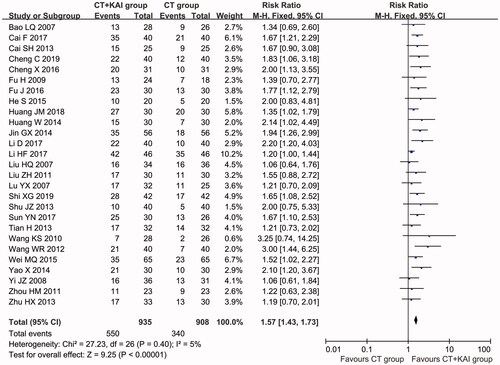
Figure 6. Comparisons of DCR between experimental and control group. Forest plot of the comparison of DCR between the experimental and control group. Control group, conventional treatment alone group; Experimental group, conventional treatment and KAI combined group. The random effects meta-analysis model (Inverse Variance method) was used.
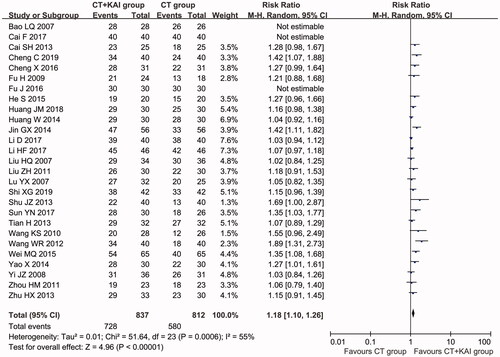
QoL assessment
Among the studies included in the present analysis, 14 trials (Liu et al. Citation2007; Lu et al. Citation2007; Cao et al. Citation2008; Fu et al. Citation2009; Huang et al. Citation2010; Wang Citation2010, Citation2012; Shu Citation2013; Tian et al. Citation2013; Zhu Citation2013; Jin et al. Citation2014; Yao et al. Citation2014; Fu Citation2016; Sun Citation2017) involving 985 participants evaluated the QoL pertaining to two groups (). The results demonstrated that the QoL pertaining to the HCC patients who underwent combination therapy was significantly improved after the treatment, compared to the patients who underwent conventional treatment alone (RR = 2.40, 95% CI = 1.79–3.23, p < 0.00001). The QoL reported by the studies included in the present analysis (P = 0.001, I2 = 62%) was observed to be heterogeneous, as per the heterogeneity test. Consequently, the random-effects model was used to analyse the RR.
Figure 7. Comparisons of QoL between experimental and control group. Forest plot of the comparison of QoL between the experimental and control group. Control group, conventional treatment alone group; Experimental group, conventional treatment and KAI combined group. The random effects meta-analysis model (Inverse Variance method) was used.
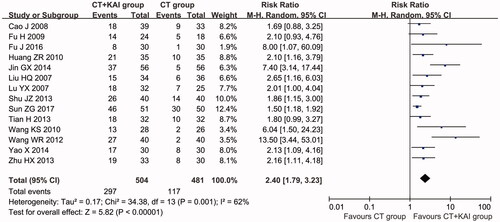
Assessment of adverse events
As shown in and Supplementary Figure 1, the patients who underwent combination therapy exhibited lower incidences of nausea and vomiting (RR = 0.74, 95% CI = 0.60–0.92, P = 0.006), liver damage (RR = 0.46, 95% CI = 0.36–0.60, p < 0.00001), peripheral neurotoxicity (RR = 0.38, 95% CI = 0.17–0.84, p = 0.02), fever (RR = 0.61, 95% CI = 0.41–0.90, p = 0.01), abdominal pain (RR = 0.51, 95% CI = 0.39–0.66, p < 0.00001), alopecia (RR = 0.31, 95% CI = 0.14–0.68, p = 0.003), increased bilirubin levels (RR = 0.45, 95% CI = 0.30–0.67, p < 0.0001), leukopoenia (RR = 0.60, 95% CI = 0.50–0.70, p < 0.00001), and reduction in haemoglobin levels (RR = 0.55, 95% CI = 0.42–0.73, p < 0.0001), compared to the patients who underwent conventional therapy, whereas the analysis of kidney damage (RR = 0.69, 95% CI = 0.38–1.26, P = 0.23), diarrhoea (RR = 0.71, 95% CI = 0.47–1.09, P = 0.12), thrombocytopenia (RR = 0.76, 95% CI = 0.56–1.04, p = 0.08), and myelosuppression (RR = 0.67, 95% CI = 0.42–1.08, p = 0.10) did not reveal any significant difference between the two groups. The incidence of nausea and vomiting showed statistical heterogeneity (p = 0.02, I2 = 51%), as per the heterogeneity test. Consequently, a random-effects model was used to pool the results in the present meta-analysis. Otherwise, the fixed-effect model was used.
Table 2. Comparison of adverse events between the experimental and control group.
Table 3. Evaluation of publication bias by trim-and-fill method.
Publication bias
Publication bias was visually assessed by means of the funnel plots and quantified using the Egger’s test and Begg’s regression test (). The funnel plots pertaining to the ORR and DCR were asymmetrical, and the regression test results indicated the presence of publication bias with regard to the same. A trim-and-fill analysis was performed, in order to determine whether the publication bias affected the pooled risk. The adjusted RR indicated a trend that was concurrent with the results of the primary analysis (), thereby reflecting the reliability of the primary conclusions.
Table 4. Subgroup analyses of ORR and DCR between the experimental and control group.
Sensitivity analysis
Sensitivity analysis was performed to investigate the influence of an individual study on the pooled results by means of the omission of one single study from the pooled analysis each time. As shown in , the results revealed that none of the individual studies significantly affected the primary outcome measures (ORR and DCR), which implied statistically robust results.
The present study also performed a subgroup analysis to explore the source of the heterogeneity in ORR and DCR with reference to the KAI dosages, duration of treatment, and sample sizes of the respective trials involved in the current analysis. The analysis revealed that the aforementioned variables, with the exception of the dosage of KAI, did not have a significant impact on the therapeutic efficacy of KAI in HCC, as shown in .
Discussion
Traditional Chinese medicine plays an increasingly important role in the treatment of several diseases, such as malaria, COVID-19 etc. (Tu Citation2016; Wang et al. Citation2018, Citation2020). KAI is a type of traditional Chinese medicine that has been clinically applied as an adjuvant therapy in HCC for decades (Song et al. Citation2014; Lu and Li Citation2018; Wan et al. Citation2018; Huang et al. Citation2019; Li et al. Citation2019). Although literature has reported the statistical analysis of published clinical trials, the exact therapeutic effect of KAI with regard to the treatment of HCC is yet to be evaluated systematically. Consequently, the present analysis performed an extensive online search, in accordance with strict inclusion and exclusion criteria, in order to arrive at clear and systematic conclusions.
Data pertaining to 35 trials mentioned previously involving 2,501 patients with advanced HCC were included in the present meta-analysis. The dosage of KAI used in all of the aforementioned studies was ranged from 30 to 60 mL per day, administered via intravenous infusion. The pooled results revealed that the combination of KAI and conventional treatment for HCC achieved more beneficial effects, compared to the treatment using conventional therapy alone.
ORR, DCR, and QoL play an important role in the assessment of the clinical efficacy of HCC treatment. KAI in combination with conventional treatment could significantly improve the ORR, DCR, and QoL in patients with HCC (p < 0.05), compared to conventional therapy alone. In order to further eliminate the influence of certain variables on the clinical effects of KAI in the treatment of HCC, the present study performed a subgroup analysis to determine the influence of the varying dosages of KAI, duration of treatment, and sample sizes on the ORR and DCR. The results of the analysis revealed that the therapeutic efficacy of KAI did not appear to be affected by the duration of treatment or the sample size, with the exception of the dosage of KAI. However, these analyses involved limited number of studies and insufficient sample sizes, which may have resulted in an inadequate assessment. Accordingly, these results need to be verified by means of further research and new evidence.
Safety is the top priority of any clinical treatment. The meta-analysis revealed that the patients who underwent a combination of KAI and conventional therapy displayed a lower risk for nausea and vomiting, liver damage, peripheral neurotoxicity, fever, abdominal pain, alopecia, increased bilirubin levels, leukopoenia, and reduction in haemoglobin levels, compared to the patients who underwent conventional treatment alone, whereas the analysis of other toxic side effects did not reveal any significant difference between the two groups. Consequently, KAI appears to be a safe, auxiliary antitumor medicine that can be used in patients with HCC.
The current analysis had certain limitations. First, as an important Chinese patent medicine, KAI is mainly used in China, which may lead to an unavoidable regional bias. Second, the current study detected publication bias with regard to ORR and DCR, which might be attributed to the tendency of some authors to deliver articles with positive results to the editors. Hence, the results should be interpreted and conclusions should be drawn with caution. Third, the results of the current study may have inherent bias, owing to the unclear randomization methods, allocation concealment, and blinding in some of the trials included in the analysis. Moreover, different trials evaluated the treatment efficacy using different outcome measures, thereby resulting in a reduction in the size of the statistical sample, which made the summary of the results on the same scale challenging. Finally, although the short-term efficacy of KAI in the treatment of advanced HCC has been verified in the present study, the verification of the long-term effects of KAI in the treatment of HCC warrants methodological and rigorous trials. Hence, considering the limitations of the studies included in the present analysis, further confirmation of the results requires high-quality, multicenter clinical trials.
Conclusions
The results of the present meta-analysis indicate that the combination of KAI and conventional treatment is effective in the treatment of patients with advanced HCC. The clinical application of KAI not only enhanced the therapeutic effects of conventional treatment, but also improved the QoL effectively and significantly alleviated the adverse effects associated with conventional therapy. Hence, the use of KAI may be a suitable complementary and alternative treatment for HCC. Conversely, the low quality of some of the publications included in the analysis increased the risk of bias, which affects the reliability of the present research to a certain extent. Hence, the scenario warrants further studies that can offer reliable evidence to verify the efficacy of KAI as an adjuvant therapy in the management of HCC.
Author contributions
Gao WN & Sun CH conceived the concept and designed the study protocol. Sun CH, Dong F & Xiao T tested the feasibility of the study. Sun CH & Dong F wrote the manuscript. Sun CH & Gao WN provided methodological advice, polished and revised the manuscript. All authors approved the final version of the manuscript.
Availability of data and material
All data generated or analysed during this study are included in this published article.
Disclosure statement
No potential conflict of interest was reported by the author(s).
References
- Anwanwan D, Singh SK, Singh S, Saikam V, Singh R. 2020. Challenges in liver cancer and possible treatment approaches. Biochim Biophys Acta Rev Cancer. 1873:188314.
- Bao LQ. 2007. Application of Kangai injection for the treatment of moderate and advanced primary liver cancer. J Hubei Coll Trad Chin Med. 9:54–55.
- Bray F, Ferlay J, Soerjomataram I, Siegel RL, Torre LA, Jemal A. 2018. Global cancer statistics 2018: GLOBOCAN estimates of incidence and mortality worldwide for 36 cancers in 185 countries. CA Cancer J Clin. 68:394–424.
- Cai SH. 2013. Curative effect observation of Kangai combined with chemotherapy for the treatment of advanced liver cancer. Chin Foreign Health Abstr. 10:142–143.
- Cai F, Wu CR, Zhang XY, Wan YJ, Cai X. 2017. Therapeutic effect of entecavir combined with traditional Chinese medicine injection on advanced liver cancer patients complicated with hepatitis B virus infection and impact on prognosis. Chin J Nosocomiol. 27:2916–2919.
- Cao J, Gu H, Ayi FH, Tai QW, Zhang JH. 2008. Clinical curative effect observation of Kangai injection in the treatment of primary liver cancer. China J Chin Mater Med. 33:2400–2401.
- Chen ZC. 2017. Clinical effect of Kangai injection combined with chemotherapy in the treatment of cancer-related fatigue of hepatocellular carcinoma patients. Inter J Ttranspl Hemopurif. 15:39–41.
- Cheng X, Yang J, Meng Y. 2016. Observation of advanced hepatocellular carcinoma chemotherapy effect of Kang’ai injection. China Cont Med Educ. 8:182–184.
- Cheng C, Zheng RF. 2019. Effect of Kang’ai injection combined with entericavir on antiviral effect and liver function in patients with advanced liver cancer. Clin Res. 27:124–126.
- Eisenhauer EA, Therasse P, Bogaerts J, Schwartz LH, Sargent D, Ford R, Dancey J, Arbuck S, Gwyther S, Mooney M, et al. 2009. New response evaluation criteria in solid tumours: revised RECIST guideline (version 1.1). Eur J Cancer. 45:228–247.
- Ferlay J, Colombet M, Soerjomataram I, Mathers C, Parkin DM, Piñeros M, Piñeros M, Znaor A, Bray F. 2019. Estimating the global cancer incidence and mortality in 2018: GLOBOCAN sources and methods. Int J Cancer. 144:1941–1953.
- Fu J. 2016. Clinical observation on improving life quality of advanced liver cancer patients with the Kang’ai injection. Clin J Chin Med. 8:73–75.
- Fu H, Yang L, Liu XH, Li XB. 2009. A case-control study of Kangai injection combined with transcatheter arterial chemoembolization in the treatment of primary liver cancer. J Clin Med Pract. 13:62–65.
- He S. 2015. To analyze the clinical effect of the treatment of advanced hepatocellular carcinoma TACE joint Kangai injection. Clin J Chin Med. 7:124–125.
- Huang JM. 2018. The effect of Kangai injection on serum tumor related substances and alpha fetoprotein in patients with liver cancer. China Health Care Nutrit. 28:75.
- Huang S, Peng W, Mao D, Zhang S, Xu P, Yi P. 2019. Kangai injection, a Traditional Chinese medicine, improves efficacy and reduces toxicity of chemotherapy in advanced colorectal cancer patients: a systematic review and meta-analysis. Evid Based Complement Alternat Med. 2019:8423037.
- Huang ZR, Yang AL, Wang RP, Ye YD. 2010. Clinical observation on Kang’ai injection in improving life quality of 35 patients with advanced liver cancer. Fujian J Tradit Chin Med. 41:8–9.
- Huang W, Zeng RX, Zhong H, Wang YJ, Luo Q, Chuan DM, Chen LC, Qing X, Zhang ZJ. 2014. Effects of Kangai injection combined with chemotherapy and embolization on advanced hepatocellular carcinoma and its effect on blood coagulation function and serum VEGF. J Hainan Med Univer. 20:1380–1382.
- Jackson D, White IR, Riley RD. 2012. Quantifying the impact of between-study heterogeneity in multivariate meta-analyses. Stat Med. 31:3805–3820.
- Jia S, Fu Y, Tao H. 2020. Trans-arterial chemoembolization combined with Jinlong capsule for advanced hepatocellular carcinoma: a PRISMA-compliant meta-analysis in a Chinese population. Pharm Biol. 58:771–784.
- Jin GX, Jin S, Sun WJ, Ji HX, Liu Y. 2014. Application value of Kangai injection on advanced primary liver cancer palliative therapy. Chin J Clin Onco Rehab. 21:1468–1470.
- Kang SL, Rao ZG, Yang B. 2015. Observation of Kang’ai-injection on quality of life in patients with hepatocellular carci-noma after TACE. J Modern Onco. 23:92–94.
- Li QS, Cao SH, Xie GM, Gan YH, Ma HJ, Lu JZ, Zhang ZH. 1994. Combined traditional Chinese medicine and Western medicine. Relieving effects of Chinese herbs, ear-acupuncture and epidural morphine on postoperative pain in liver cancer. Chin Med J. 107:289–294.
- Li HX, Ji YJ, Zhang SP, Gao ZS, Hu C, Jiang RL, Chen MJ, Li GC, Zhang X. 2019. Kangai injection combined with platinum-based chemotherapy for the treatment of stage III/IV non-small cell lung cancer: a meta-analysis and systematic review of 35 randomized controlled trials. J Cancer. 10:5283–5298.
- Li HF, Xu Q, Shen YF, Jiang MH, Lu DB. 2017. The effect of Kang’ai injection in patients with hepatocellular carcinoma treated with TACE combined with MWA. Onco Prog. 15:515–517.
- Li D, Zhao F, Wang SG. 2017. Effect of Kangai injection combined with transcatheter arterial chemoembolization on coagulation function and serum VEGF in patients with advanced liver cancer. Modern J Integr Trad Chin West Med. 26:3375–3377.
- Lin L, Chu H. 2018. Quantifying publication bias in meta-analysis. Biometrics. 74:785–794.
- Ling CQ, Fan J, Lin HS, Shen F, Xu ZY, Lin LZ, Qin SK, Zhou WP, Zhai XF, Li B, et al. 2018. Clinical practice guidelines for the treatment of primary liver cancer with integrative traditional Chinese and Western medicine. J Integr Med. 16:236–248.
- Liu ZH. 2011. Clinical observation of Kang'ai injection on advanced liver cancer with chemotherapy. Guide China Med. 9:30–31.
- Liu HQ, Chen SX, Li Y, Huang RW. 2007. Clinical observation of Kang’ai-injection with TACE in 34 patients with hepatocellular carcinoma (HC). Hainan Med. J. 18:19–20.
- Liu J, Liu X, Ma J, Li K, Xu C. 2019. The clinical efficacy and safety of kanglaite adjuvant therapy in the treatment of advanced hepatocellular carcinoma: a PRISMA-compliant meta-analysis. Biosci Rep. 39:BSR20193319.
- Lu YX, Huang DP, Hou NC, Qin B, Huang Y. 2007. Clinical effect observation of Kangai injection combined with TACE in the treatment of primary liver cancer. China J Chin Mater Med. 32:2655–2656.
- Lu Q, Li CL. 2018. Therapeutic efficacy and safety of Kang-ai injection combined with platinum-based doublet chemotherapy in advanced NSCLC: a meta-analysis. Life Sci. 210:9–19.
- Ma L, Wang B, Long Y, Li H. 2017. Effect of traditional Chinese medicine combined with Western therapy on primary hepatic carcinoma: a systematic review with meta-analysis. Front Med. 11:191–202.
- Moher D, Liberati A, Tetzlaff J, Altman DG. 2009. Preferred reporting items for systematic reviews and meta-analyses: the PRISMA statement. J Clin Epidemiol. 62:1006–1012.
- Ning Y. 2017. Antiviral effect analysis of entecavir combined with Kangai injection and effect on the improvement of liver function in patients with advanced liver cancer. Modern J Integr Trad Chin West Med. 26:1991–1993.
- Shi XG. 2019. The effect of Kangai injection combined with lamivudine on the therapeutic effect and liver function of patients with advanced liver cancer and HBV infection after transcatheter arterial chemoembolization. Anti-Infect Pharm. 16:513–515.
- Shi L, Lin L. 2019. The trim-and-fill method for publication bias: practical guidelines and recommendations based on a large database of meta-analyses. Medicine. 98:e15987.
- Shu JZ. 2013. Therapeutic effect observation of Kangai injection combined with chemotherapy for patients with moderate and advanced liver cancer. Seek Med Ask Med. 11:121–122.
- Song WX, Chen M, Cheng MJ, Zhang Z. 2014. Progress in clinical application of Kangai injection. Mod Hosp. 14:47–52.
- Song Q, Yang W, Meng Z, Wang J. 2020. Protocol for a systematic review and meta-analysis of Kang-ai injection for patients with oesophageal cancer. Medicine. 99:e22148.
- Sun YN. 2017. The clinical effect of Kangai injection combined with entecavir in the treatment of HBV related advanced liver cancer and its effect on liver function. Chin J Critic Care Med. 37:113–114.
- Sun ZG. 2017. Clinical observation of Kangai injection in improving the quality of life of patients with advanced liver cancer. J North Pharm. 14:29.
- Tian H, He ZK, Xu QJ. 2013. Clinical observation on 32 cases of primary liver cancer treated by Kangai injection combined with TACE. Nat Med Front China. 8:46–47.
- Tu Y. 2016. Artemisinin-A gift from traditional Chinese Medicine to the World (Nobel Lecture). Angew Chem Int Ed Engl. 55:10210–10226.
- Wan YM, Li YH, Xu ZY, Wu HM, Xu Y, Yang M, Wu XN. 2018. The effect of transarterial chemoembolization in combination with Kang’ai injection on patients with intermediate stage hepatocellular carcinoma: a prospective study. Integr Cancer Ther. 17:477–485.
- Wang KS. 2010. Clinical observation of Kangai injection in the treatment of moderate advanced liver cancer. China’s Naturopathy. 18:41–42.
- Wang WR. 2012. Response of Kang-ai injection in palliative treatment for advanced primary hepatocellular carcinoma. China Cancer. 21:874–876.
- Wang Z, Chen X, Lu Y, Chen F, Zhang W. 2020. Clinical characteristics and therapeutic procedure for four cases with 2019 novel coronavirus pneumonia receiving combined Chinese and Western medicine treatment. Biosci Trends. 14:64–68.
- Wang S, Long S, Wu W. 2018. Application of Traditional Chinese medicines as personalized therapy in human cancers. Am J Chin Med. 46:953–970.
- Wei MQ. 2015. Research about effect of the influence of Kang’ai injection on the complement system and fibrosis state of patients with hepatic carcinoma. Pract J Cancer. 30:613–615.
- Xi SY, Minuk GY. 2018. Role of traditional Chinese medicine in the management of patients with hepatocellular carcinoma. World J Hepatol. 10:799–806.
- Xue JX, Zhu ZY, Bian WH, Yao C. 2018. The Traditional Chinese medicine Kangai injection as an adjuvant method in combination with chemotherapy for the treatment of breast cancer in Chinese patients: a meta-analysis. Evid Based Complement Alternat Med. 2018:6305645.
- Yang RY, Zhang HW. 2010. Effect of Kangai injection on quality of life in patients with advanced hepatic cancers. Chin J New Drug. 19:1575–1577.
- Yao X, Zhang DX, Yu CS. 2014. Curative effect observation of Kangai injection in the treatment of liver cancer with portal vein cancer-thrombus. Chin J Trad Med Sci Tech. 21:448–449.
- Yi JZ, Xie YC, Deng XH. 2008. Clinical observation on the effect of Kang’ai injection combined with transcatheter arterial chemoembolization on hepatocellular carcinoma in 36 patients. Tumor. 28:997–1000.
- Zeng X, Zhang Y, Kwong JS, Zhang C, Li S, Sun F, Niu Y, Du L. 2015. The methodological quality assessment tools for preclinical and clinical studies, systematic review and meta-analysis, and clinical practice guideline: a systematic review. J Evid Based Med. 8:2–10.
- Zhang Y. 2015. The clinical effect of entecavir combined with Kangai injection in the treatment of HBV related liver cancer after transcatheter arterial chemoembolization. Modern J Integr Trad Chin West Med. 24:3363–3365.
- Zhou HM, Zhang AQ, Zhang ZH. 2011. The application research of traditional Chinese medicine combined with TACE in the treatment of primary liver cancer. China Health Industry. 8:88–89.
- Zhu HX. 2013. Clinical curative effect observation of TACE combined with Kangai injection in the treatment of advanced primary liver cancer. China Pract Med. 8:156–157.
- Zhu M, Liu X, Zhou C, Li J. 2020. Effect of sodium cantharidinate/vitamin B6 injection on survival, liver function, immune function, and quality of life in patients with hepatocellular carcinoma: protocol for a meta-analysis. Medicine. 99:e21952.
- Zhu J, Yin T, Xu Y, Lu XJ. 2019. Therapeutics for advanced hepatocellular carcinoma: recent advances, current dilemma, and future directions. J Cell Physiol. 234:12122–12132.

